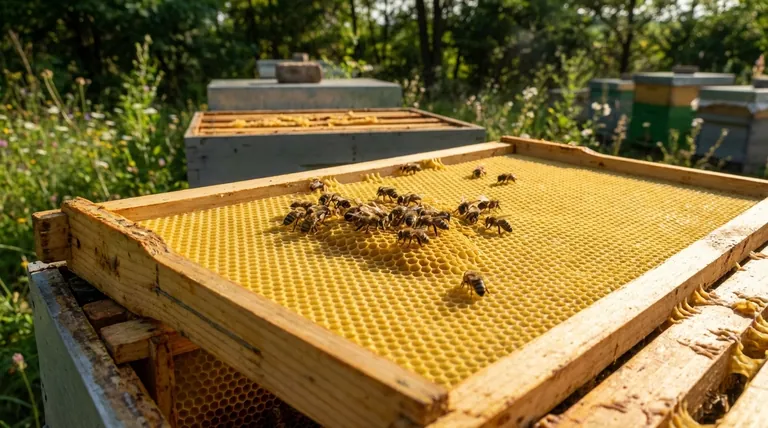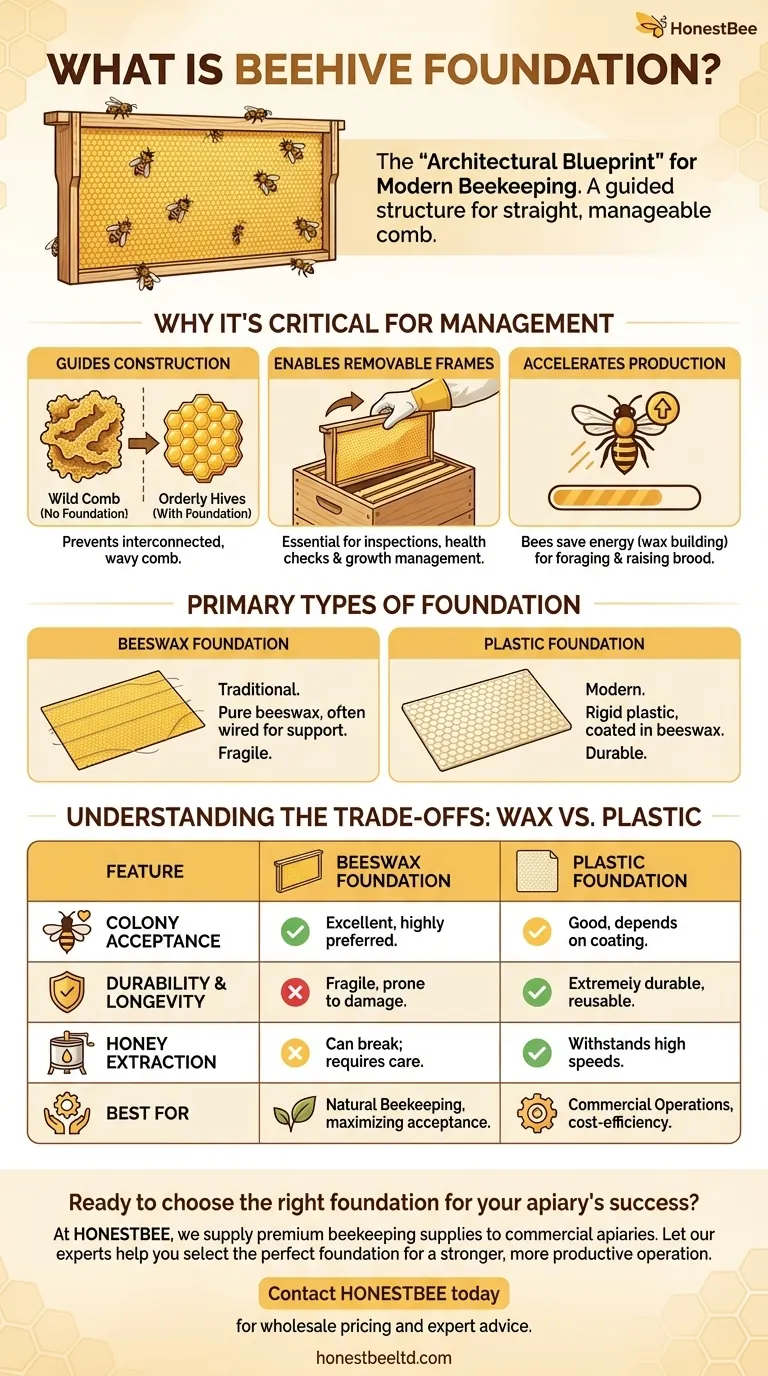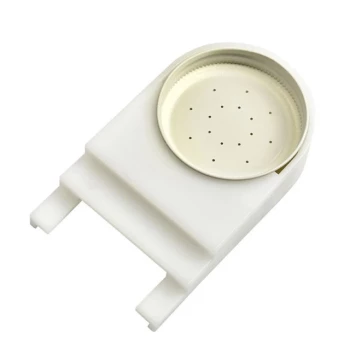In beekeeping, foundation is the architectural blueprint provided to a honeybee colony. It is a thin sheet, typically made of beeswax or plastic, imprinted with the hexagonal cell pattern of a honeycomb. This guide is placed inside a wooden frame, giving the bees a precise starting point and structure on which to build their comb.
The core purpose of beehive foundation is to control where and how bees build their comb. This ensures the comb is straight and contained within removable frames, which is the foundational principle of modern, manageable beekeeping.

Why Foundation is a Critical Management Tool
Before the invention of foundation, bees built comb naturally within a cavity, attaching it to the sides and top. This "wild comb" made it impossible to inspect the hive for disease or to harvest honey without destroying the comb and angering the colony.
Guiding Construction for Orderly Hives
Bees are incredibly efficient builders, but without guidance, their comb can be wavy, interconnected, and firmly attached to the hive body. Foundation encourages them to build perfectly straight, organized comb.
Enabling Removable Frames
The straight comb built on foundation allows each frame to be removed individually. This is the single most important aspect of modern beekeeping, as it enables beekeepers to inspect the queen's health, check for pests or diseases, and manage the colony's growth.
Accelerating Comb Production
Building honeycomb requires an enormous amount of energy from the bees; they must consume large quantities of nectar to produce tiny flakes of wax. By providing a foundation, the beekeeper gives them a significant head start, allowing the colony to redirect its energy toward foraging and raising brood.
The Two Primary Types of Foundation
While various styles exist, the choice for most beekeepers comes down to two materials: traditional beeswax or modern plastic.
Beeswax Foundation
This is the most traditional option, made from sheets of pure beeswax. It often includes embedded wires for structural support, which prevents the soft wax from sagging under its own weight and the heat of the hive.
Plastic Foundation
This is a rigid sheet of food-grade plastic molded with the hexagonal cell pattern. It is almost always coated with a thin layer of beeswax to encourage the bees to accept it and begin building upon it.
Understanding the Trade-offs: Wax vs. Plastic
Choosing between beeswax and plastic foundation involves a direct trade-off between natural acceptance and operational durability. Neither is universally "better"; the right choice depends on your goals.
Acceptance by the Colony
Bees almost always accept and draw out comb on beeswax foundation more readily than plastic. It is a natural material they produce themselves. Sometimes, colonies can be reluctant to build on plastic foundation if the wax coating is thin or has lost its scent.
Durability and Longevity
Plastic foundation is vastly more durable. It will not sag in high heat, is less likely to be damaged by pests like wax moths, and can be scraped clean and reused for many seasons. Beeswax foundation is fragile and can easily be damaged during handling or extraction.
Ease of Honey Extraction
The rigidity of plastic foundation is a major advantage during honey harvesting. It can withstand the high rotational speeds of a centrifugal extractor without breaking apart, or "blowing out." Fragile beeswax comb can easily be destroyed in an extractor if not handled carefully.
Making the Right Choice for Your Apiary
Your philosophy and operational goals will determine the best foundation for your hives.
- If your primary focus is natural beekeeping and rapid colony acceptance: Pure beeswax foundation is the most traditional choice and is what bees will work with most willingly.
- If your primary focus is durability, long-term cost, and harvesting efficiency: Plastic foundation offers superior strength, reusability, and resilience in the honey extractor.
Ultimately, foundation is the critical interface that allows the beekeeper to work in partnership with the colony's natural instincts.
Summary Table:
| Feature | Beeswax Foundation | Plastic Foundation |
|---|---|---|
| Colony Acceptance | Excellent, highly preferred by bees | Good, depends on wax coating |
| Durability & Longevity | Fragile, prone to damage and sagging | Extremely durable, reusable for many seasons |
| Honey Extraction | Can be damaged in extractors; requires care | Withstands centrifugal force; ideal for extraction |
| Best For | Natural beekeeping, maximizing acceptance | Commercial operations, durability, and cost-efficiency |
Ready to choose the right foundation for your apiary's success?
At HONESTBEE, we supply premium beekeeping supplies and equipment to commercial apiaries and distributors. We understand that the right foundation is critical for hive health, honey production, and operational efficiency. Let our experts help you select the perfect foundation—whether durable plastic for high-volume extraction or pure beeswax for optimal colony acceptance—to build a stronger, more productive operation.
Contact HONESTBEE today for wholesale pricing and expert advice tailored to commercial beekeeping needs.
Visual Guide

Related Products
- Beeswax Foundation Sheets Beehive Foundation for Wholesale
- Food Grade Plastic bee Foundation for Bee Frames
- Manual Beeswax Comb Foundation Machine Wax Foundation Mill Embossing Machine
- HONESTBEE Professional Long Handled Hive Tool with Precision Cutting Blade
- HONESTBEE Advanced Ergonomic Stainless Steel Hive Tool for Beekeeping
People Also Ask
- What happens after the flattening and embossing process is complete? From Molten Wax to Solid Foundation
- What is 'foundation' in beekeeping, and why is it used? Optimize Hive Management & Honey Production
- What are the characteristics of beeswax foundation? A Natural Choice for Healthy Hives
- How do you store beeswax foundation? Prevent Wax Moth Damage and Preserve Quality
- How do beeswax foundations save bees time and energy? Boost Hive Productivity & Honey Yield



















